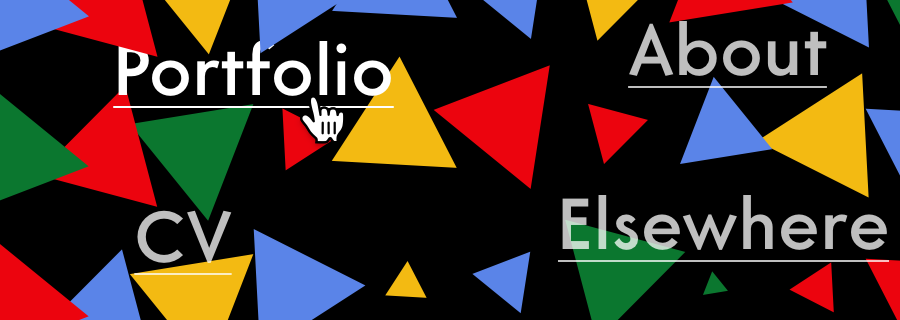An opinion piece on The Next Web titled It’s Time to Kill the Personal Website raised a lot of eyebrows last month. Wait, what? Designers? Portfolio? No more?
Insane! Of course designers need portfolios!, we said at Sympli.
Here's why, in our opinion.
Social Media !== Portfolio
Okay, it can do, but isn't that lazy?
In theory, it sounds like a smart and simple idea—uploading your work to Facebook is easy, right? But then it begs the question: other than with your work, how are you setting yourself apart from other designers? Having a custom website is about more than just showing off your work. It's about convincing clients to like you, and conveying your morals and personality in a visually constructive way.
Portfolios are useless if not used correctly
Some custom-built websites are utterly useless, agreed.
We won't name and shame, but if the content includes nothing more than your name, a one-liner about what you do (especially if it's something stupidly vague like "I design things"), and links to your social media channels on a fancy "big header" background, then yes, maybe you've wasted your time there.
Generally speaking, it says nothing about you, your values, or your reputation.
On the other hand, if you're offering an optimal user experience and you're clear in your mind about what you want your website to achieve (for example…more clients, a window-shopping experience for current clients, a blog on-the-side to speak to your audience and build authority, an online store on-the-side for selling designed products as a means of generating passive income, et cetera, et cetera), then you can craft an experience that tells your story in a compelling way.
Not only do you want the client to think: "Hey, I like that designers work!", but also "Hey, I like that designer as a person and want to work with him!".
Conveying Your Personal Brand
Social media is essentially a white label solution. You can't visually tweak your page beyond being able to change your cover image, and in the case of Twitter, the colors. You can't talk about values and work, unless you share a post or tweet.
And this is important. You're a designer, your overall role is about finding ways to communicate things through imagery, words and colors. If you're limited in how you can communicate, then you're limiting your self-expression, and clients will find it hard to hire you if they can't hear your true, amazing voice.
Having a visual identity means that the client is offered the chance to resonate with you; to agree on your values, to feel comfortable with your rates, to actually decide if they like you as a person (yes, a portfolio can be somewhat casual and speak about your outside-of-work hobbies and interests). Personal branding, or any branding really, is about your tone-of-voice as well as the fonts and colors.
Personal branding is about how you speak and what you believe in. Some clients, unbelievably enough, will subconsciously value their fondness for you over your actual talent. Portfolios that are custom-built can depict this, but with a social media channel, this becomes much harder because of user limitations.
Social Media: Other Downsides
One thing that really caught our eye in the aforementioned article, was that the author claimed that social media was easy to use (in the sense that you can simply upload an image anytime). In theory that is true, but is social media really that easy to use? Perhaps this is subjective, but is Facebook really user-friendly? Personally, I wouldn't say so, no. What about Instagram? Could you share your best design work there? Yeah, maybe, but only via your mobile device, since Instagram only works in a read-only state in the browser. Again, more limitations.
What happens when a social media website shuts down? I'm looking at you, Yahoo! 360, Windows Live Spaces and Orkut.
On a different (but more important note), would it really matter that much if custom-built websites were harder to manage? Portfolios are for the benefit of the client, not the designer—they're for life, it's a worthy investment of your time.
Bring the essence of social media to your custom-built website
Many employers check the social media accounts of potentially awesome employees to try and understand more about them. Does this mean that we should use social media for business? First of all, yes, you should always try to use social media for business, but that doesn't mean that we should use it exclusively. In fact, you can totally make your custom website as casual as you'd like (it should "talk" to visitors how you'd talk to them in real life).
The more the client learns about you, the more they're able to like you as an individual. At the end of the day, you're a person, and if you don't sound like you have a personality, you won't turn heads. If you're relying solely on your social media accounts for this, the restrictions are going to limit your voice.
Bring your personality to your custom site. Design it in a way that conveys your casual side like a social media account would, reducing the number of steps the client has to take to figure you out. You don't need to wow them with visual experiences and website "features"; in fact, that would probably confuse them.
Portfolios are not complex apps, they should be simple.
Just not vague, simple.
Conclusion
Being visible online is seemingly useful for literally anybody these days, but as a designer or developer, you should be able to prove that you can communicate things about yourself accurately and effectively. A short bio is not enough, and anything that you share on Twitter is limited to 160 characters and is only visible as until you share your next tweet. Tell your story in a bold, effective way.


